
Jacques Cousteau was the first to dive on the S.S. Thistlegorm in the 1950s. Sadly, as was the practice at the time, he took various items from the wreck, including the ship’s bell. Cousteau kept the location of the Thistlegorm quiet, and it was not until the early 1990s that divers once again located the site, using information from fisherman. The UK’s Dive magazine estimates that since then, over one million divers have visited the wreck.
The dive boat lurched in the chop as we waited for the crew to fasten the descent line. It was blowing 15-20 knots and white caps streaked the water. Geared-up and ready, we sat on the timber benches, and I have to admit I was feeling nervous. It didn’t seem all that long ago that I had done my first scuba dive, and now I was waiting to descend to the bottom of the Gulf of Suez to explore the S.S. Thistlegorm. Due to the challenging nature of the site, most tour operators stipulate divers must have completed at least 20 logged dives, and hold certain qualifications, before they can visit the wreck. I had the bare minimum in the bank. However, I knew my instructor Ayman would not allow me to dive if he didn’t think I could handle it. The other members of our 4-person team, Lars and Nadine, were experienced divers who had visited the Thistlegorm before, so I knew I was in good hands.

A shout from one of the crew and it was time to go. We staggered across the deck to the stern in our gear, grabbing hand holds and steadying ourselves as we went. I watched the others jump one by one, then it was my turn. Stepping off the stern I was suddenly in a rush of wind, waves and foam. Ayman grabbed me and dragged me to the ropeline, and hanging on tight, we began our descent. Hand over hand we moved deeper, the waves and current buffeting us as we clung to the whipping rope. Looking down, the Thistlegorm slowly came into view in the green and the gloom, lying where she fell 79 years ago.
Nearing the bottom of the rope, Ayman let go and signaled for us to do the same. Although the wind and waves did not disturb the water 25 metres down, the current was strong. We drifted alongside the hull of the ship, past the point where the bombs had struck, to the stern which was lying on its side. I remember have rushes of excitement, tempered by the knowledge that I was visiting a war grave. The ship’s single propeller came into view, and we drifted over the blades and around the stern.
Exploring the stern of the Thistlegorm. Video by Lars
Ayman guided us to the stern deck, where the Thistlegorm’s two guns were clearly visible. Leading us to a box of artillery shells, he showed us the date stamped on the base of one of the rounds; 1929. The armaments added to the merchant ships were often outdated, and it appeared as if the rounds were also aged. I nearly put my hand on a scorpion fish lying motionless and supremely camouflaged beside the boxes of ammunition.
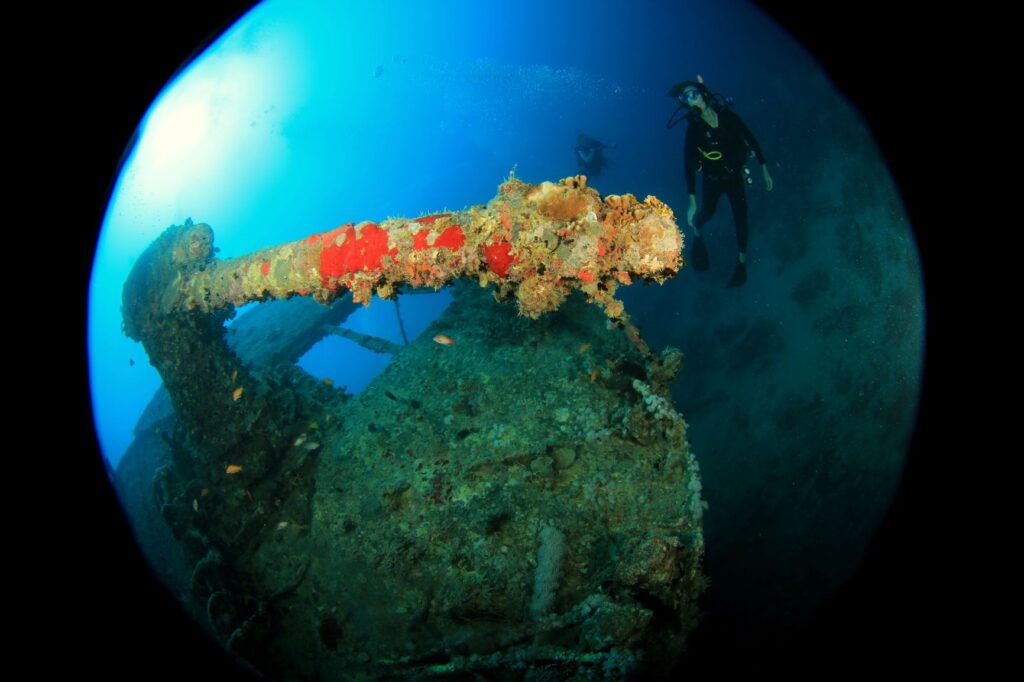
We swam against the current, along the top of the ship to the bow. It was hard work, and in the exposed areas I felt like I was making no forward progress at all. The ship’s superstructure provided some shelter and made the going a little easier. I watched tiny fish similarly struggling to keep their place in the water. Being a complete beginner at wreck diving, I found it surreal to see hatches, ladders, steps, surfaces and everyday items designed to permit movement and existence on a floating ship lying at the bottom of the water.
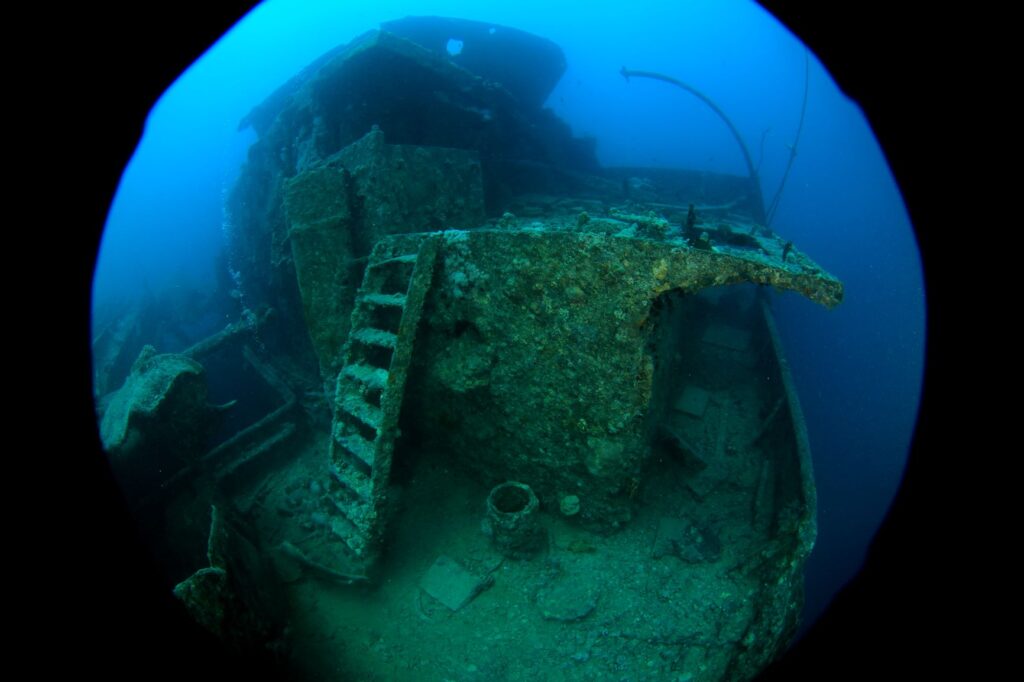
Reaching the bow, we let ourselves drift back towards the descent/ascent rope, rapidly picking up speed as we flew across the top of the Thistlegorm. Reaching the rope, we began our hand-over-hand ascent, our bodies swinging out from the rope, parallel to the current. At 5 metres depth, we paused for our 3 minute ‘safety stop’, which permits time for some of the absorbed nitrogen to be released from the body. Ayman controlled the stop, while the three of us, as Nadine would later describe, clung to the rope flapping like flags on a flagpole. With the safety stop complete, Ayman gave us the signal to surface, and once again we were fighting the wind and waves, working hard to get back on the boat.
Even though the Red Sea water temperature is warm, after time at depth – and now standing in the wind in our wetsuits – we were shivering. After changing, and preparing our gear for the next dive, we chatted about what we had seen, and how powerful the current had been flowing past the Thistlegorm. I was pleased to have some time to recover and collect my thoughts before the next dive, where we would enter the the holds of the ship.
I was nervous again when suiting up for the second dive. The conditions were challenging for me, and I would now be entering an enclosed wreck for the first time. However at least I knew what to expect from the chop on the surface and the current down below. Into the lurching swell we dropped, then descended once again via the mooring line. Once at the Thistlegorm, Ayman lead us into the hull. Just like I had read, and seen in the photos online, The ship’s holds were packed tight. It was a veritable Aladdin’s cave of World War Two history.
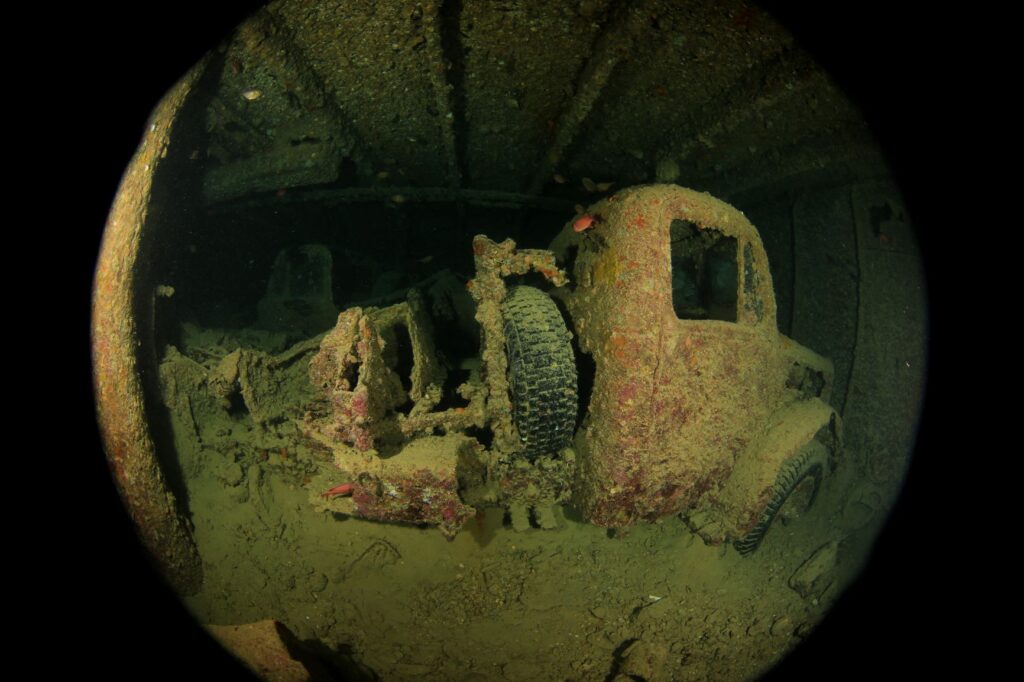
Inside the gloom of the ship, we flicked on our torches. Red soldierfish huddled in schools in the corners of the holds, their big eyes watching as we passed. Room after room held lines of flat-bed trucks, packed tight side by side, some timber planking still in place in their trays. Motorcycles were stacked upright in the backs of some of the vehicles, their grooved rubber tyres still looking remarkably fresh. We skimmed over the top of the bikes, our tanks clearing the ceiling by only a couple of feet. I remember thinking at the time that I couldn’t believe I was actually doing this.
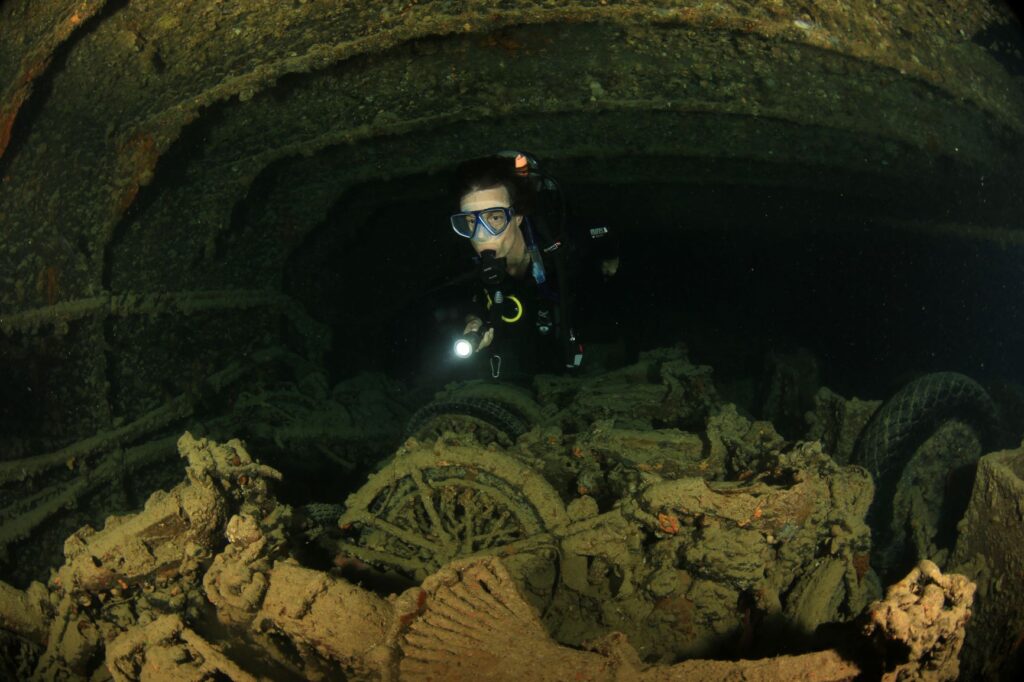
Ayman lead us from room to room within the holds, through hatches, doorways and holes in the wreck. We saw aircraft parts, including a steel rack holding wings, and a radial engine. Strangely, considering the supplies were heading to Egypt, there were also a large number of rubber wellington boots on board.
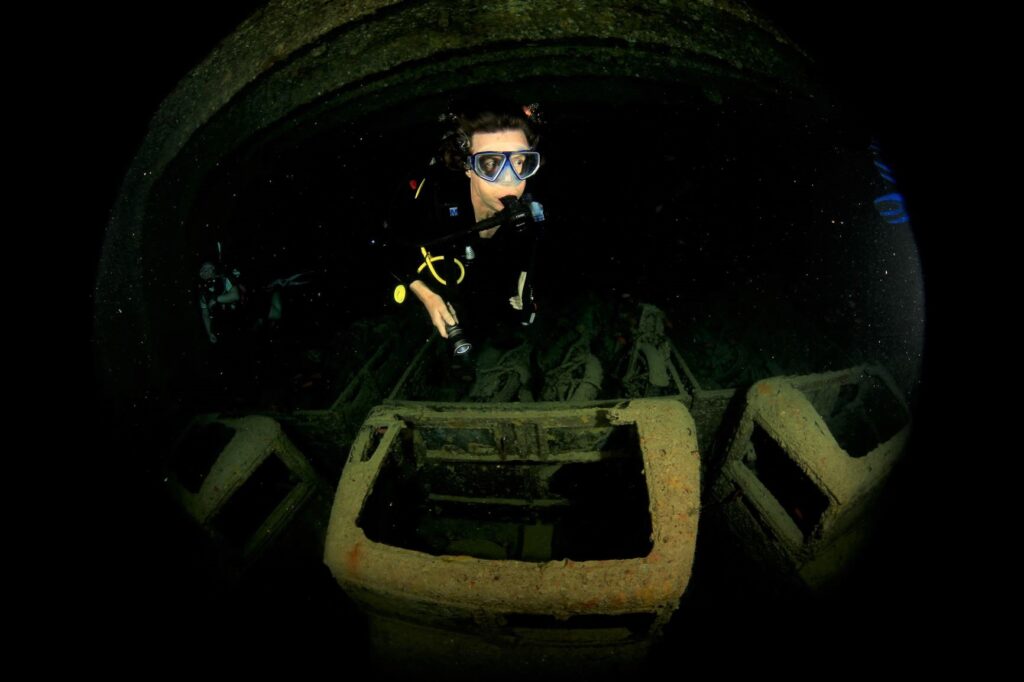
After viewing the holds we headed to the captain’s quarters, where inside a small alcove sat a porcelain bath tub. Although we were inside a wreck, it was still strange to see bath sitting there so far underwater. It was a very human thing too: somewhere the skipper freshened up, or perhaps took a few minutes to quietly relax, taking a break from the stressful job of guiding a sought-after target through treacherous waters.
Since I started diving, I have felt that time under water seems to go in a flash. With the overwhelming experience of exploring inside the Thistlegorm, this was particularly true. The 35 minutes we spent underwater passed in a blur, and suddenly it was time to ascend. We climbed the rope to our safety stop once more, the current and surge seeming particularly strong after the relative calm inside the ship. On Ayman’s signal, we slowly surfaced, and scrambled up the ladder as the stern heaved in the swell.
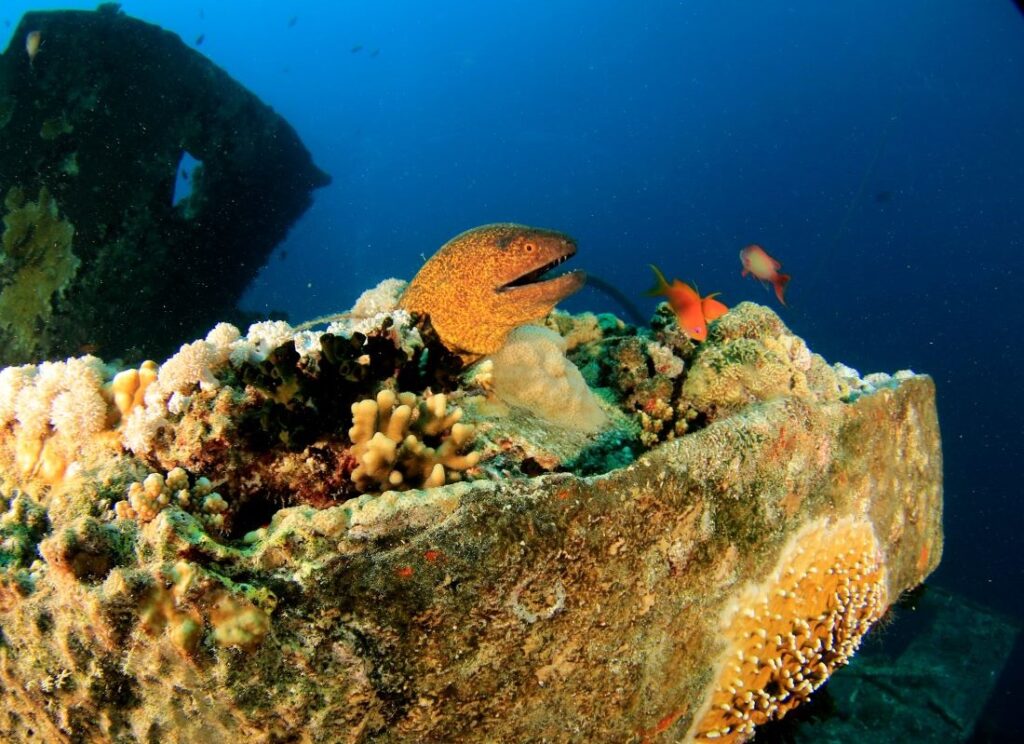
Back on board it was time to share wide-eyed stories of what we had seen. After reading about the history of the S.S. Thistlegorm, the story had vividly come to life on the bottom of the Gulf, where the evidence of that fateful night all those years ago was still clear to see.
The popularity of diving the Thistlegorm has inevitably lead to impacts on the site, and threats to the integrity of the ship are only likely to intensify. Management action is required to protect the wreck, whilst permitting divers to continue to experience this unique site. As World War II fades further into the past, allowing visits to the S.S. Thistlegorm provides an opportunity to keep history alive, and to remember the sailors who lost their lives on the 6th of October, 1941.
If you enjoyed this post, you may also like The Thistlegorm, HMS Lundy and HMS Louis
Do you have a particular interest in World War I, II and the Cold War? Check out my other blog Ghosts of War. If you enjoy military history, and want to know what it’s like to visit both significant and lesser-known wartime locations today, there’s something there for you.
Leave a Reply